© 2009 Bill St. Arnaud, Larry Smarr, Jerry Sheehan, and Tom DeFanti. . The text of this article is licensed under the Creative Commons Attribution-NonCommercial-NoDerivs 3.0 License (http://creativecommons.org/licenses/by-nc-nd/3.0/).
EDUCAUSE Review, vol. 44, no. 6 (November/December 2009): 14-33
We enter 2010 at a turning point in the debate on global climate change, in which the focus is rapidly moving from a scientific analysis of how human activity affects climate to a political discussion on how best to regulate greenhouse gas (GHG) emissions so as to lessen the human and environmental toll of global climatic disruption. Policymakers in many countries are actively engaged in drafting legislation at the local, state/province, and federal levels to enact substantial regulatory limits on GHG emissions. Colleges and universities, being swept up in this legislation, will soon have to begin to measure and abate campus GHG emissions or face potential fiscal repercussions.
Modifying the current societal use of carbon-based fuels is exceedingly complex, and at-scale experiments on carbon reduction techniques need to be carried out immediately. Since college and university campuses are effectively small cities, they are an ideal scale for exploring innovative approaches to the reduction of carbon footprints. Realizing that this challenge may also be an opportunity, a number of higher education institutions are turning themselves into experimental, living laboratories of the "greener" future.1 By transforming their building, transportation, and electrical-generation energy subsystems into instrumented testbeds, institutions can use their actions to reduce carbon footprints as learning and optimization environments for society at large.
Information technologies -- including networked computing, storage, and visualization (also collectively termed cyberinfrastructure) -- are rapidly being adopted across all campuses as research and education become increasingly digital. These technologies hold a key to early carbon reductions. However, the increased use of these technologies is a uniquely double-edged sword regarding climate change, since the manufacturing, electrification, and cooling of IT equipment itself is a significant GHG contributor.
For example, the Climate Group (http://www.theclimategroup.org), in its "SMART 2020" report, estimates information and communications technology contributions to global GHG emissions to be about the same as that of the aviation industry -- some 2-3 percent.2 Furthermore, the report notes that this industry is rapidly growing in its emissions, estimated to roughly triple between 2002 and 2020. On the other hand, the report also estimates that greater use of these technologies can result in overall reductions of roughly 15 percent of total "business as usual" emissions by 2020, through applications to carbon minimization in industry, transportation, buildings, and power. This applies to campuses in the areas of intelligent infrastructure (transportation and building) and dematerialization (digital paper and elimination of travel).
The message for higher education is clear: to decrease campus GHG emissions overall to meet emerging carbon regulation, institutional leaders need to reduce the campus carbon footprint by decreasing the emissions of their existing cyberinfrastructure, while they simultaneously increase their use of cyberinfrastructure in areas such as intelligent infrastructure and dematerialization. In the process, green innovations of campus researchers can appear on the "over the horizon" radar for society as a whole, offering an essential head start on the socioeconomic transition from a high-carbon to a low-carbon global system.
Reducing the Campus Carbon Footprint: Intelligent Infrastructure
Major reductions in GHG emissions from campuses are possible by developing renewable sources of energy for the generation of electricity, by creating "smart electrical grids" in campus buildings, and by transforming the campus transportation fleet to low-carbon.
Smart Electrical Grids and Buildings
In the United States, the electrification, lighting, heating, and cooling of buildings accounts for around 40 percent of all CO2 emissions.3 Although efforts to create more sustainable buildings are under way -- for example, new construction at both the University of California, San Diego (UCSD) and the University of California, Irvine (UCI) will be Silver or Gold Leadership in Energy and Environmental Design (LEED) certified -- increased attention to design alone will not be sufficient. Rather, what is needed is the deployment of embedded sensors providing better real-time energy management so that the building occupants can adjust their behavior and so that smart autonomous management systems can be created to decrease lighting, power, and cooling demands. For example, UCI is installing "smart" real-time air quality sensing in laboratories to cut energy consumption by as much as 50 percent. "Smart lab" parameters include reducing air changes from six to four per hour, slowing fume hood-face velocities from 100 FPM to 60 FPM (40 FPM when unoccupied), and running exhaust stacks at minimal velocities when wind conditions allow.
UCSD is applying a campus-scale approach in which approximately sixty campus buildings have their electrical energy use available online in real time through a web interface (http://mscada01.ucsd.edu/ion/) (see Figure 1). These meters collect power-use data for electrical loads from Metasys, a commercial direct digital energy management system that is connected to the largest campus buildings and serves a combination of constant volume and variable air volume HVAC systems. The collected data is converted and made available using an open protocol OPC (OLE for Process Control), which drives visualization interfaces including detailed energy usage.
Figure 1. UCSD web interface showing real-time energy usage for a subset of the buildings on campus
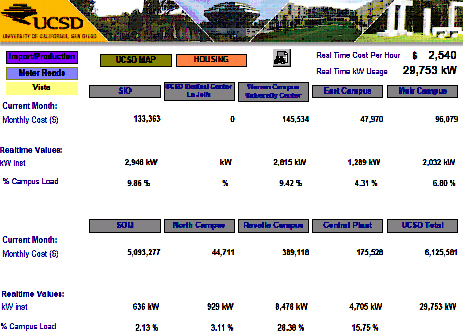
Drilling down to individual buildings, the new UCSD Computer Science and Engineering (CSE) building is being instrumented as a testbed for campus monitoring of comprehensive energy. Professor Rajesh Gupta and his colleagues have worked with the UCSD facilities management team to instrument this mixed-use building that houses 500 people and more than 1,000 computers.4 The sub-metering currently monitors power use on fifteen separate circuits, as well as over forty endpoint plug loads. The monitoring breaks out power use by building areas (floors and wings), as well as by functional use such as lighting, PC and laptop plug loads, HVAC, and servers.
Gupta can graph the total power use in kW (averaged over fifteen-minute intervals) of the CSE building (see Figure 2). He finds that the peak load (caused by turning on the building's mechanical systems for air conditioning during the day) is nearly twice the baseline electricity load. In contrast, the building lighting load, which is what most occupants focus on to reduce electrical use, is only 15 percent of the base load.
Figure 2. Variation of the electrical load in the UCSD CSE building during a week in August 2009

Source: Yuvraj Agarwal, Thomas Weng, and Rajesh Gupta, "The Energy Dashboard: Improving the Visibility of Energy Consumption at a Campus-Wide Scale," paper presented at the Association for Computing Machinery (ACM) BuildSys 2009 Workshop, Berkeley, California, November 3, 2009
This means that more than half of the current baseline electrical usage for the CSE building could be saved by selective reduction in energy use of computers when they are not being used. Gupta and his team are developing detailed instrumentation to measure macro- and micro-scale power use augmented by an operational wireless networking testbed consisting of 39 sensors and 156 radios. This will allow the development of technologies that enable fine-grained and autonomous management of power use by IT equipment. Since many campus buildings that house researchers will have similar profiles, controlling the use of IT equipment in the buildings may be "low-hanging fruit" for reducing the overall base electrical load of a campus, thus reducing the campus carbon emissions. Doing so will also become a major new activity for campus IT professionals over the coming decade as they partner in new ways with their facilities colleagues.
Intelligent Transportation
The United States accounts for nearly 45 percent of all vehicle miles driven in the world. Road congestion domestically is estimated to cost Americans $200 billion in lost economic productivity, wasting 3.7 billion hours and 2.3 billion gallons of fuel per year.5 In California, 40 percent of GHG emissions come from transportation.6
To help eliminate congestion, embedded roadway sensors can provide information to commuters through the web, handheld devices, or intelligent vehicle navigation systems. For instance, Calit2 has developed the California Wireless Traffic Report, an intelligent traffic management system (http://traffic.calit2.net/). Deployed in San Diego, Silicon Valley, and San Francisco, the report allows thousands of users each day to receive automated alerts when their primary routes become congested and thus to alter their routes. The report also aggregates daily data on the commute time of these drivers and shares this information so that drivers can make data-driven decisions on when the best time is each day for them to leave for their commute to avoid traffic congestion. Meanwhile, Calit2 is also partnering with UCI's Institute of Transportation Studies (http://www.its.uci.edu/), which houses a distributed online database for traffic on the Orange County freeways; this system enables transportation management using cooperating roadside and in-vehicle communication devices.
Since most colleges and universities have their own transportation fleets, converting them to low- or zero-carbon emitting vehicles is a logical first step. Shuttle buses that are integrated with wireless global positioning system (GPS) and that provide riders with applications for smart phones can form a very efficient and useful people-moving system on campus. At UCI, the Advanced Power and Energy Program (http://www.apep.uci.edu/) -- which consists of the National Fuel Cell Research Center (NFCRC), the UCI Combustion Laboratory, the Distributed Technologies Testing Facility, and the Pacific Rim Consortium on Combustion, Energy, and the Environment -- is working with Toyota to test early models of plug-in electric hybrid cars. Over the last decade, the NFCRC and the Institute of Transportation Studies have also tested all-electric and hydrogen fuel cell vehicles, and they operate two hydrogen-refueling stations.7 This allows system-scale research on campus alternative-energy transportation solutions. In 2007, UCI became the first campus in the nation to retrofit its shuttle system for B100 (pure biodiesel), reducing campus carbon emissions by an estimated 480 tons annually.
UCSD has an ambitious program under way to reduce the carbon footprint of its fleet, of which approximately 45 percent are already alternatively fueled vehicles. Included in this number are over three hundred small electric and more than fifty hybrid vehicles. Additionally, the campus fleet has converted its entire diesel fuel supply to a B20 biodiesel blend.8 Recently, UCSD purchased five "Fast-Charging Compressed Natural Gas (CNG)-Electric" buses for its shuttle fleet. To support the buses, fueled by CNG, the campus is installing a CNG station that will support, in addition to the buses, other heavy- and light-duty CNG vehicles that are being added to the fleet.9 Finally, through a partnership with San Diego Gas & Electric, in 2010 the campus will take delivery of its first all-electric, full-sized vehicle: the Nissan Leaf. Through grant funding from the U.S. Department of Energy, the campus will also receive charging infrastructure along with the electric vehicles. By 2011, UCSD will have as many as twenty full-sized electric vehicles in its inventory.
Finally, UCI is expanding on-campus housing, giving the university the highest percentage of on-campus students in the University of California System and thus eliminating much of the need for commuting. The U.S. Environmental Protection Agency presented the university with an Environmental Achievement Award for its Sustainable Transportation program, which eliminates more than 18,000 mTCO2e annually by promoting alternative transportation, such as car sharing, bicycling, and walking. UCI also earned the state's most prestigious environmental honor: a 2008 Governor's Environmental and Economic Leadership Award for climate change for its green commuting and transportation program.
Reducing the Campus Carbon Footprint: Dematerialization
Dematerialization is another area in which the use of cyberinfrastructure can lead to greener campuses. The "SMART 2020" report defines dematerialization as the substitution of high-carbon products and activities with low-carbon alternatives — for example, replacing face-to-face meetings with videoconferencing or using online systems instead of paper-based processes.10 Many colleges and universities are already moving toward online systems to replace much of their paper-based processes, but those institutions may not be considering this as a method for reducing their carbon footprint.
One area of in which higher education can show leadership is in the conversion to digital textbooks. A study commissioned by the Institute for Prospective Technological Studies noted that the dematerialization and virtualization of physical products such as books, DVDs, and newspapers can result in significant reductions of overall GHG emissions.11 A good example of this approach is the recent announcement that Amazon is providing its Kindle DX e-book reader as a replacement for textbooks in six university trials throughout the United States. Not only will this save students' backs, but it will also reduce the carbon footprint in the manufacturing and shipment of textbooks.
According to a study by the Babcock School of Management, one pound of textbooks produces five pounds of CO2, one pound of printer paper generates four pounds of CO2, and one pound of newspaper produces three pounds of CO2.12 Much of this carbon emission can be avoided by giving students devices such as e-book readers. Moreover, with expected regulation, carbon will eventually trade at over $100 per metric ton, which would go a long way to paying for e-books through carbon savings. California is spearheading these national efforts with the announcement, by Governor Arnold Schwarzenegger in June 2009, of a digital textbook initiative aimed at gradually phasing out hardcopy textbooks for K-12 classes at all state schools.13
The use of mixed physical and virtual meeting spaces can also have a significant impact on reducing transportation emissions by avoiding unnecessary travel. Networked high-definition video systems can create the impression that two rooms in different places are "joined" into a single virtual/physical room. Calit2 uses commercial high-definition video conferencing systems (see Figure 3) to allow for meetings in which both the UCSD and the UCI members are in one virtual/physical auditorium.
Figure 3. The September 8, 2009, Calit2 All Hands Meeting in a mixed virtual/physical setting that "sews together" the two Calit2 auditoriums at UCSD and UCI (photo credit: Erik Jepsen, Calit2 UCSD)
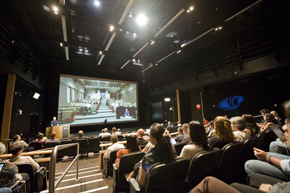
At the next level of realism, Cisco has been an early leader in the deployment of these technologies (http://www.cisco.com/telepresence). As of August 2009, it had more than 533 TelePresence units located in 163 major cities in 45 countries worldwide, resulting in the elimination of nearly 70,000 face-to-face meetings -- an environmental impact equivalent to taking over 25,000 vehicles off the road and saving 150,000 metric tons of emissions.14 Currently, both Calit2 buildings and partners at the Electronic Visualization Laboratory (EVL) at the University of Illinois, Chicago (http://www.evl.uic.edu), are being equipped with Cisco TelePresence units.
Calit2 and EVL have been exploring how to best create mixed physical/virtual spaces using streaming digital media (either high-definition or digital cinema) for collaborative analysis of high-resolution data through the OptIPuter project (http://www.optiputer.net), funded by the National Science Foundation. Using uncompressed15 or lightly compressed high-definition video over both the National LambdaRail and the Global Lambda Integrated Facility (GLIF, http://www.glif.is) dedicated optical fiber networks, Calit2 and EVL are providing a prototype for the next generation of telepresence to support international research collaborations.
In January 2008, as a project of the Australian American Leadership Dialogue, Calit2 and Australia's University of Melbourne integrated an OptIPortal (high-resolution tiled wall display built by the University of Melbourne using Calit2 technologies) with lightly compressed high-definition video (http://www.qvidium.com) to support a series of presentations using the OptIPortal with interactions from audiences at both ends (see Figure 4).16 This landmark broadband communications demonstration used the dedicated optical gigabit/s network of Pacific Rim GLIF members (AARNet, Pacific Wave, and CENIC). All the technical consulting was done via the Internet, so no Calit2 staff members needed to fly to Melbourne to help bring up that end of the connection, which eliminated even more potential carbon emissions. There are now nine of these OptIPortals in Australia and another fifty worldwide, many of which are being interconnected to support the OptIPlanet Collaboratory.
Figure 4. The virtual/physical space "sewing together" the University of Melbourne and the Calit2 auditorium at UCSD (photo credit: Pinar Istek, Calit2 UCSD)
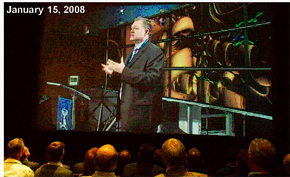
A year later, Calit2 at UCSD had set up a persistent collaborative workspace with the new NASA Lunar Science Institute (http://lunarscience.nasa.gov/) at NASA Ames Research Center in Mountain View, California, using the CENIC dedicated 10 Gbps optical network. By combining OptIPortals and commercial video teleconferencing units at both ends, teams are able to jointly explore high-resolution images from the new Lunar Reconnaissance Orbiter, as well as from the Mars Exploration Rovers (see Figure 5). In addition to reducing the carbon emissions associated with flying, the very existence of these collaborative systems greatly increases the frequency with which the collaborating sites interact, speeding up the pace of research between them.
Figure 5. NASA investigator Larry Edwards (on screen) in front of the NASA Lunar Science Institute's OptIPortal doing a "virtual handshake" with Calit2's Kai-Uwe Doerr, who is standing in front of the HIPerSpace OptIPortal in the Calit2 at UCSD building (photo credit: Erik Jepsen, Calit2 UCSD)
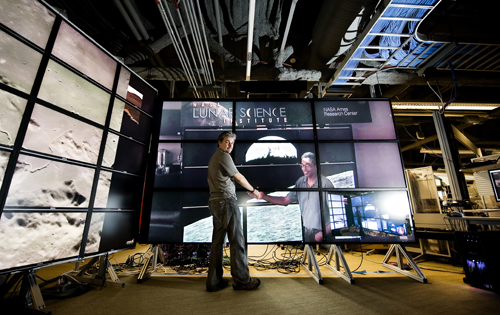
In summary, the increasing use of low-carbon telepresence, via high-capacity research and education networks such as these, will reinforce and accelerate the global trend toward more data-intensive research collaborations. But since it is important that the deployment of these networks themselves do not create additional GHG emissions, research into the best low-carbon architectures of future international networks is essential.
Reducing the Campus Carbon Footprint: Data Centers
Data centers are central to campus emission-reduction strategies. The "Smart 2020" report estimates that by 2020, nearly 20 percent of all global IT GHG emissions will be caused by data centers,17 leading industry, federal laboratories, and academia to focus on ways to measure and reduce these "hot spots."18 In July 2008, the Silicon Valley Leadership Group (SVLG), in conjunction with Accenture and Lawrence Berkeley National Laboratory, released a report that documents eleven real-world technology initiatives and seventeen case studies performed over sixteen months by data center operators, technology providers, and policy experts as part of the SVLG's Data Center Demonstration Project. The report shows that dramatic energy reductions are already taking place as best practices are being shared and implemented on a global basis.19
Instrumented Data Centers
UCSD is extending this trend from the data center operators to the application end users. In the GreenLight Project (http://greenlight.calit2.net/), funded by the National Science Foundation, UCSD is creating the GreenLight Instrument, a set of eight instrumented racks (each of which can hold up to forty 1U servers) of computing, storage, and networking hardware installed (see Figure 6) in a Sun Microsystems Modular Datacenter (http://www.sun.com/products/sunmd/s20/). The goal of the UCSD GreenLight Project is analogous to putting a calorimeter into the networked server complex. The project allows researchers to measure and quantify various parameters — such as disk drive access, optimized computer code, and network loading — that affect energy consumption.
Figure 6. Two Sun Microsystems Modular Datacenters at UCSD (left) and one of the eight racks pulled out with a load of 1U PCs (right) (photo credit: UCSD)
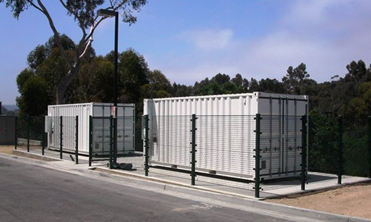
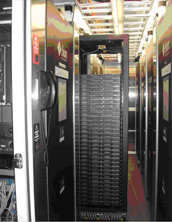
Online power-distribution units and harness-measurement systems provide energy-usage data in real time, including information on power usage and efficiency both for individual components and for the servers themselves. These measurements include details on energy consumption for computing and communicating, as well as for handling airflow, heat exchanger dissipation, chilled water flow, and related thermal management systems. Concordant with the goal to explore remote location of such facilities, UCSD's modular data centers have 10Gbs networking to each of the racks, so that accessing data in the servers themselves is unlikely to be a bottleneck.
GreenLight allows the measurement, monitoring, and public availability of real-time sensor outputs of equipment running a wide variety of applications and algorithms. The ultimate goal of GreenLight is to make the proliferation of computer servers more energy-efficient by instrumenting and driving both long-term and real-time improvements in "work-per-watt" through virtualization software/middleware, as well as through hardware architectural shifts into multi-core,20 general-purpose graphics-processing units and field-programmable gate arrays.21 Energy usage data, both current and archival, will be available in real time over the Internet to assist energy-efficiency research. Through carefully implemented service-oriented architectures, GreenLight plans to allow researchers anywhere to run test jobs and measure comparative work-per-watt for their codes.
To get an idea of the scale of energy savings possible, consider the work of Tajana Å imuni?-Rosing, a GreenLight computer science researcher and the director of the UCSD System Energy Efficiency Lab (http://seelab.ucsd.edu), who is exploring energy-efficiency approaches using closed-loop power and thermal-management strategies. She has developed an optimal dynamic power-management algorithm for a given class of workloads by monitoring the system characteristics and the statistical properties of the workload. When coupled with machine learning to select adaptively among these specialized policies, this approach can lead to a measured energy savings of up to 70 percent per device with variable workloads. Å imuni? Rosing has also demonstrated how the same machine learning algorithms can be used, along with thermal sensors, for online adaptation between a set of dynamic thermal-management algorithms to obtain the best temporal and spatial thermal profiles. Further reduction of up to 60 percent in thermal hot spots with no performance overhead can be obtained by using proactive thermal-management strategies.22 This innovative work has attracted a number of industrial partners as well as federal government sponsors.23
To provide a wide range of disciplinary applications, GreenLight targets research scientists from five communities -- metagenomics, ocean observing, microscopy, bioinformatics, and digital media -- who, through this instrumentation, will understand how to measure and then minimize energy consumption, to make use of novel energy/cooling sources coming online at UCSD, and to employ middleware that automates the optimal choice of compute/power strategies.
Powering Data Centers with Zero-Carbon Energy Generation
With this data, researchers can undertake a baseline emissions measurement and can quantify the specific carbon offsets that could be earned if the computational and network equipment is optimized for energy efficiency. However, in addition to making the data center more energy-efficient, campuses can actually get rid of all the carbon emissions by switching to zero-carbon energy generation for the data center.
The UCSD solar voltaic and fuel cells generate over 5 MW of direct current (DC). Currently, two of GreenLight's racks are fully DC-fed, preparing for a second modular data center installation. The integration of renewable energy generation with DC loads is now partially funded by a California Energy Commission Smart Grid Integration award. The "DC to DC" modular data center design concept includes an intermediate power enclosure with a rectifier and energy storage device for 400 Volts of DC (VDC) power and a DC-DC power converter to take the 650 VDC from the fuel cell to 400 VDC. Thus, servers within the DC modular data center, fitted with available 400-VDC power supplies, will be unaware of an external power supply of 480 VAC from the distribution grid or 650 VDC from the fuel cell.
This advanced energy system will serve as a decentralized, diurnal peak reduction system, allowing load shifting of up to 200 KW to be removed from the grid at any time to address regional energy shortfalls. It also provides energy savings by eliminating power conversion losses for both the AC and the DC options. Of course, the DC modular data center itself is a proof-of-concept for allowing the placement of servers near the source of zero-carbon DC power.
Placing Data Centers near Remote Zero-Carbon Energy Generation Sites
In the GreenLight example, the modular data center acts as a local cloud for computing and storage. Many cyberinfrastructure and IT applications can easily run on similar energy-managed cloud computers, whether they are "cluster condominiums" operated by colleges/universities or are the commercial variety (e.g., Google, Amazon, Yahoo, MSN), which have created vast data center complexes and are beginning to offer "excess capacity" as services. However, as long as these large-scale data centers are run off of conventionally generated electrical power, the institution's carbon footprint — though it can be moderated as described above — remains significant.
In contrast, if remote data centers are run and cooled from sources of zero-carbon-emission (e.g., solar, hydro, fuel cell, wind) or low-carbon-emission (e.g., bio-fuels) energy, then much more significant savings in GHG emissions can be realized. Using more renewable energy has long been a recognized goal of the IT industry, but increasing the amount of renewable power as part of an energy mix is complicated by the fact that most renewable energy sources are in remote locations. The IT industry, distinct from any other sector, is ideally suited to having some of its infrastructure located at renewable energy sites, as long as there are high-speed optical network connections nearby. Many large data centers deployed by Google, Microsoft, and others have already adopted this strategy, often using old aluminum-smelting facilities that have high electrical current leads to hydro plants.
An IT infrastructure deployed at renewable energy sites has a number of advantages. One is the completely independent and redundant power infrastructure, consisting of the traditional infrastructure provided by electrical utilities in cities and another infrastructure based on independent renewable power sources located largely outside of cities. More important, by locating network nodes at renewable power sites, network providers will have a greater certainty of price, since they will not be competing with other industry sectors for the same power, leading to time-dependent fluctuations in price.
Several initiatives of this sort are under way:
- MIT and the University of Massachusetts have proposed to build a new data center at a small hydroelectric dam ninety miles outside of Boston, in the town of Holyoke.24
- A number of countries are exploring the relocation of domestic scientific research high-performance computing facilities to Iceland, where they will be powered and cooled by cost-effective, environmentally friendly, geothermal and hydro energy.25
- Geodynamics (http://www.geodynamics.com.au), a renewable energy company in Australia, is proposing to place data centers next to geothermal/solar energy sources it is developing in central Australia.
The biggest challenge in being disconnected from the conventional electrical grid and in using renewable energy sources such as windmills and solar panels to power data centers and networks is reliability. Researchers and educators will not tolerate computing or network services that are intermittent and/or unreliable — no matter how green they purport to be. To address this challenge, Prompt (a Canadian university-industry consortium), the University of British Columbia, and UCSD have signed a "Memorandum of Understanding" to develop collaborative research programs for identifying solutions that will enable the deployment of reliable zero-carbon networks, cyberinfrastructure, and data centers.26 This collaborative initiative is open to any North American institution that is interested in reducing its GHG footprint.
In August 2009, the Canada-California Strategic Innovation Partnership (CCSIP) announced the funding of the Canada-California Consortium for a Zero Carbon Internet, which will identify opportunities for green IT pilots on campuses in California and Canada, thereby raising awareness of GHG and carbon footprint issues. In addition, CANARIE (http://www.canarie.ca), Canada's national research and education network organization, has launched the C$3 million Green IT Pilot Program, an initiative intended to help catalyze industry-academia partnerships in developing zero-carbon cyberinfrastructure solutions.27 The program encourages the development, testing, and demonstration of new network and cyberinfrastructure architectures that will provide the same reliability and usability of current systems, but in which computer servers, databases, and network nodes are relocated to zero-carbon data facilities powered solely by renewable resources.
The intent of these programs is to deploy working prototype network and cyberinfrastructure architectures where computation and network nodes are powered by renewable energy sources such as windmills, micro-hydro, geothermal, and solar-powered systems. Reliability and redundancy are achieved through the use of clouds and virtualization using middleware developed for cyberinfrastructure grids. In many ways, the challenges of building a zero-carbon computing and network infrastructure are no different from those of building a traditional computational grid in which the availability of resources, such as computation cycles and network bandwidth, now also include the carbon footprint of available power.
Learning How to Reduce the Carbon Footprint
Clearly, with the growing efforts to reduce carbon emissions from college and university campuses, information needs to be shared quickly across the community. One way this has been happening is through a series of international ad hoc workshops. In Canada, CANARIE and CAUBO (Canadian Association of University Business Officers) have held workshops on how institutions can reduce their carbon footprints. (There is a sense of urgency on this topic in Canada, since it is expected that many Canadian provinces will follow the lead of British Columbia and will mandate carbon neutrality.)
In Australia, the University of Melbourne hosted the Symposium on Sustainability of the Internet and ICT in November 2008, bringing together leaders from industry, not-for-profits, and education for a two-day workshop. In the United States, Calit2 and the California Public Utilities Commissions hosted the Greening of the Internet Economy workshop in January 2009, bringing a similar U.S. stakeholder community together to examine the impact of carbon legislation on IT, data center power efficiency, smart buildings, smart grids, intelligent transportation, and IT-enabled carbon-minimization efforts.
To build on the success of these community events, we believe that an international "Greening the Internet" symposium should be held annually, alternating the physical hosting sites around the globe. Technical efforts should be undertaken to create "virtual conference audience sites" to allow for the greatest international participation and to reduce the carbon footprint of attendance. An important aspect of such a program is educating college and university CIOs and researchers about the value of earning carbon offsets by undertaking initiatives such as relocating servers and databases to zero-carbon data centers.
Conclusion: The University Leadership Opportunity
Higher education institutions have a long and successful history of creating both scientific and technological innovations for the benefit of society. Indeed, the U.S. land-grant institutions were established, in large part, to support the need for leading-edge research in the dominant industry of the time: agriculture. Today, those of us in higher education have the opportunity to recommit ourselves to enabling societal transformation by using our campus "cities" as proofs of concept for the green infrastructure revolution. By focusing not only on how we can make our campus cyberinfrastructure more energy-efficient, but also on how we can use that cyberinfrastructure for even larger energy savings in our building and transportation infrastructure, as well as adopting dematerialization tactics, we can learn a number of best practices that can be transferred to society at large, thereby speeding the day when global GHG levels will stabilize.
The authors thank the Australian American Leadership Dialogue for the opportunity to develop an early white paper (with our colleague Rod Tucker at the University of Melbourne), which informed this article. Support from the National Science Foundation through the GreenLight Major Research Instrumentation grant CNS-0821155 and from Calit2 and CANARIE was essential for our work. We appreciate useful comments from Phil Smith, Ramesh Rao, GP Li, Rajesh Gupta, Steve Relyea, Eric Lane, Scott Samuelson, Wendell Brase, Rick McGeer, Shellie Nazarenus, and Amy Bennion for a critical reading of the draft manuscript.
- For example, see: American College & University Presidents' Climate Commitment (http://www.presidentsclimatecommitment.org); Amanda Leigh Mascarelli, "How Green Is Your Campus?" Nature, vol. 461 (September 10, 2009).
- The Climate Group, on behalf of the Global e-Sustainability Initiative (GeSI), "SMART 2020: Enabling the Low Carbon Economy in the Information Age" (2008), <http://www.theclimategroup.org/assets/resources/publications/Smart2020Report_lo_res.pdf>.
- Ibid.
- Yuvraj Agarwal, Thomas Weng, and Rajesh Gupta, "The Energy Dashboard: Improving the Visibility of Energy Consumption at a Campus-Wide Scale," paper presented at the Association for Computing Machinery (ACM) BuildSys 2009 Workshop, Berkeley, California, November 3, 2009.
- The Climate Group, "SMART 2020."
- "California Greenhouse Gas Chart: 2007," California Green Solutions website, <http://www.californiagreensolutions.com/cgi-bin/gt/tpl.h,content=978>.
- See the following Calit2 web articles: July 25, 2007, <http://www.calit2.net/newsroom/release.php?id=1138>; October 29, 2007, <http://www.calit2.net/newsroom/article.php?id=1186>; August 25, 2005, <http://www.calit2.net/newsroom/article.php?id=674>. And see the NFCRC Hydrogen Program website: <http://www.nfcrc.uci.edu/2/ACTIVITIES/PROJECTS/hydrogen/HydrogenFuelingStations.aspx>.
- The B20 blend (20% biodiesel and 80% petroleum diesel fuel) helps to reduce GHG and particulate emissions from the campus.
- These first-of-a-kind buses, which will eventually operate more than 50 percent of the time on electric power, rely on a CNG-fueled turbine to charge the lithium-ion batteries that power the electric motor drive. Operating a majority of the time in the all-electric mode using "fast-chargers," which can take the onboard batteries from a 40 percent to 80 percent charge in less than thirty minutes, will provide a significant leap forward in decreasing transportation-generated emissions. The CNG station also provides the basic infrastructure for UCSD's future "Alternative Fuel Station," which will provide both hydrogen and hydrogen/CNG (HCNG) blend fueling capability.
- The Climate Group, "SMART 2020."
- "The Future Impact of ICTs on Environmental Sustainability" (November 2004), <http://ipts.jrc.ec.europa.eu/publications/pub.cfm?id=1208>.
- "Pounds of CO2 per Pound of Stuff," BlueSkyModel.org, <http://www.stewartmarion.com/carbon-footprint/html/carbon-footprint-stuff.html>.
- "Governor Holds Press Conference with Education Officials Regarding Digital Textbooks Initiative," Office of the Governor, June 8, 2009, <http://gov.ca.gov/speech/12462/>.
- Cisco, private communication with the authors.
- iHDTV (http://www.washington.edu/ihdtv/) has been pioneered by the University of Washington's Research Channel (http://www.researchchannel.org).
- Calit2 web article, January 16, 2008, <http://www.calit2.net/newsroom/release.php?id=1219>.
- The Climate Group, "SMART 2020."
- See, for example: Dell, "Unlock Your Hidden Data Center," <http://www.dell.com/hiddendatacenter?ST=green%20data%20center&dgc=ST&cid=33433&lid=787077>; "HP's Green Business Technology Initiative," <http://h71028.www7.hp.com/enterprise/cache/331475-0-0-0-121.html>; Pacific Northwest National Laboratory, "ESDC: Energy Smart Data Center," <http://esdc.pnl.gov/>; "Effort Under Way to Make Computing on Campus 'Green,'" Stanford University News, <http://news-service.stanford.edu/news/2008/october15/sustech-101508.html>; Paul K. Wright, "Information Technology and Its Impact on Energy and the Environment," <http://www.citris-uc.org/files/07-Paul-Wright-Case-Study-on-Data-Centers.pdf>.
- Silicon Valley Leadership Group, "Data Center Energy Forecast," July 29, 2008, <http://svlg.net/campaigns/datacenter/docs/DCEFR_report.pdf>.
- Almir Mutapcic, Stephen Boyd, Srinivasan Murali, David Atienza, Giovanni De Micheli, and Rajesh Gupta, "Processor Speed Control with Thermal Constraints," IEEE Transactions on Circuits and Systems (Part I, 2009).
- J. Coburn, N. Bandeira, P. Pevzner, V. Bafna, N. Castellana, R. Gupta, and K. Collins, "Approaching Real-Time Protein Identification from Mass Spectrometry Data," 57th ASMS Conference on Mass Spectrometry, June 2009.
- G. Dhiman and T. Å imuni? Rosing, "Using Online Learning for System Level Power Management," IEEE TCAD (2009); A. Coskun, T. Å imuni? Rosing, K. Whisnant, and K. Gross, "Static and Dynamic Temperature-Aware Scheduling for Multiprocessor SoCs," IEEE TVLSI (2008); A. Coskun and T. Å imuni? Rosing, "Proactive Thermal Management," IEEE TCAD (2009).
- Research supported by DARPA, DOD, NSF, FCRP via GSRC and MuSyC centers, UC Micro, and CNS, plus industrial partners Cisco, Google, HP, Texas Instruments, Qualcomm, and Sun Microsystems.
- "Cisco, EMC Team with MIT to Launch $100M Green Data Center," <http://www.greenercomputing.com/news/2009/06/11/cisco-emc-team-with-mit-launch-100m-green-data-center>.
- "Iceland: Refrigerating a Green Data Centre," CIOL, June 26, 2009, <http://www.ciol.com/Enterprise/News-Reports/Iceland-Refrigerating-a-green-data-centre/26609121591/0/>.
- Calit2 web article, October 27, 2008, <http://www.calit2.net/newsroom/release.php?id=1411>.
- Green IT Pilot Program, <http://www.canarie.ca/funding/greenit/call_for_proposals.html>.
